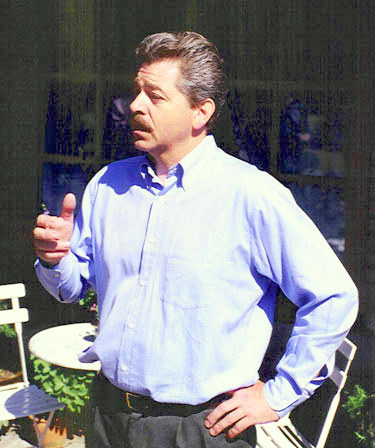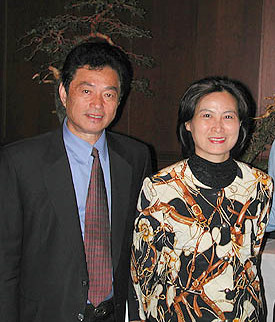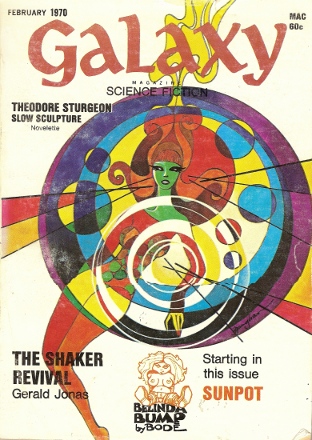| 21 |
1940 -- The first of two lectures and demonstrations on "Dwarf Tree Culture" was given by Ronald Shigeru Kawahara at the
Honolulu Academy of Arts in Hawaii at 10:30 on this
Wednesday morning. Kawahara was a graduate of Japan's
Chiba
Horticultural College. [A week later the second lecture would be presented here.]
(Honolulu Academy of Arts'
News
bulletin and calendar: Volumes 13-15 and
this link
also.) SEE ALSO: Sep Also
1991 -- The Latin-American Bonsai Federation (FELAB) was formally organized in Cali, Columbia. The Board of Directors representing nine countries included Solita Tafur as president. ("Latin-American Bonsai Federation Organized" by Jose R. Santisteban, Bonsai Magazine, BCI, July/August 1992, pg. 15) |
||||
| 22 |
1952 -- Budi Sulistyo was born in Magelang, Central
Java, Indonesia. [He would start doing bonsai in 1976 right before he graduated from the Faculty of English
teaching, IKIP Sanatadharma, Yogyakarta, Central Java.
Graduating from Civil Engineering at Gajah Mada University in 1979, he would move the next year to
Jakarta, and then join the
Indonesian Bonsai Society
two years later at age 30.
That organisation would have been founded in 1979 and was dormant with only 7 members when Budi would join. He would first
begin to teach the art in 1984. He would then give seminars and teach in classes and workshops throughout his country,
and on national television for almost ten years since 1986. He would be the first Indonesian to win an international
award (1988, International Bonsai Exhibition in Osaka, Japan) and would become well-known and respected in the
bonsai community. Other awards would follow. He would write three bonsai books in the Indonesian language and one,
Tropical Bonsai Gallery, in English. In 2007 he would be the chief of operation in the 9th Asia-Pacific Bonsai
& Suiseki Exhibition and Convention in Bali. He would be the vice president of the Indonesian Bonsai Society,
the secretary general of the Indonesian Suiseki Association and a director of Bonsai Clubs International. All of that would
actually be second to his main job as the director of a real estate company developing houses, offices and shopping complexes.]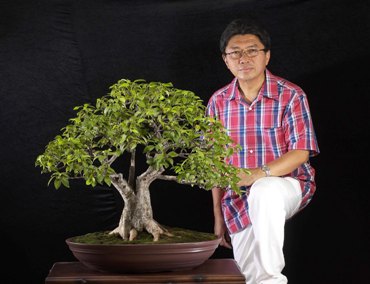
|
||||
| 23 |
1909 -- George Hull was born in New York City. [As an author
and photographer, he would go on to be a well-known figure in the horticultural
world, and would be involved in the early days of both Bonsai Clubs International
and the American Bonsai Society.]
("About George Hull" by Dorothy Ebel Hansell,
Bonsai Journal, ABS, Spring 1975,
p. 15, with photograph; "In Memory...George Hull,"
Bonsai Magazine, BCI,
Jan/Feb 1975, p. 16) SEE ALSO: Nov 21
1923 -- Kenko Rokkaku was born near Kanuma City, Japan. [He would
become a promoter of Satsuki (azalea) bonsai, including being the publisher of Japan's only magazine exclusively
devoted to that subject, as well as the monthly Wildflowers and Alpine Plants.] 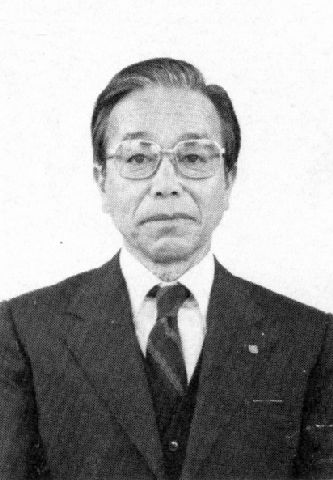
Kenko Rokkaku (Bonsai Magazine, BCI, May/June 1986, pg. 17) ("Biography of Mr. Kenko Rokkaku" by Bill Spencer, Bonsai Magazine, BCI, May/June 1986, pg. 17) SEE ALSO: Mar 2
1955 -- French dramatist, poet, and diplomat Paul Claudel died
in Paris. (He had been born on Aug. 6, 1868 in
Villeneuve-sur-Fère, into a family of farmers and gentry.
Having spent his first years in Champagne, he studied at the
lycée of Bar-le-Duc and at the Lycée Louis-le-Grand in
1881, when his parents moved to Paris. Claudel was prolific,
authoring many plays, essays, poems and Christian apologetics. He
had many admirers and detractors. He made no concessions to the
public. Claudel's writings deal largely with man's inner spirit,
and reveal the influence of his profound and mystical
Catholicism. In his theatrical works Claudel combined extensive
use of symbols—primarily religious—and exotic backgrounds with the
techniques of pantomime, ballet, music, and the cinema. He was a
diplomat from 1893 to 1936, and many of his works were written during
this time, mirroring his global experiences. He was first
vice-consul in New York
(April 1893), and later in Boston (December 1893). He was French
consul in China (1895-1909), in Prague (December 1909), Frankfurt am
Main (October 1911), Hamburg (October 1913),
ministre plénipotentiaire
in Rio de Janeiro (1916), Copenhagen (1920), ambassador in Tokyo
(1922-1928), Washington, DC (1928-1933), and Brussels (1933-1936).
In 1936 he retired to his château in Brangues
(Isère). During the 1940's Claudel opposed the Nazis,
writing a triumphal ode to Charles DeGaul. He was elected at the
Académie française in 1946. His poetry, at
once devout and extraordinarily erotic, was then widely read. His
plays, many long considered unstageable, were finally being performed
to enthusiastic audiences. Said to be a misogynist, an
anti-semite and an Islamophobe, he was also regarded as one of the 20th
century's greatest dramatists. At his death his mental powers
were as keen as ever until the very end and, some say, his high temper
and animosities stayed strong as well.) (Ever since his death his
reputation would fluctuate violently. In France, the nature,
meaning and acceptability of his work remain the subject of
debate. In the UK, however, he has largely slipped from view.)
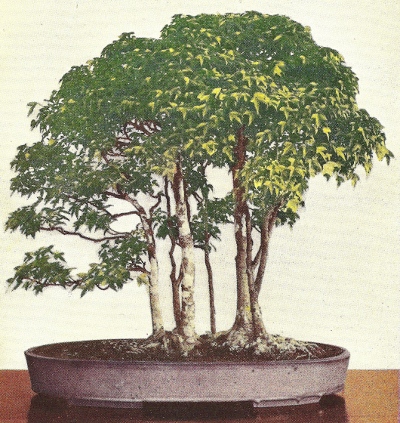
Tokaede (Trident Maple) forest
Also, earlier Claudel had written in an introduction to his sister Camille Claudel's sculpture exhibition in France in 1905:(Kobayashi, Bonsai -- Miniature Potted Trees, frontispiece) "Just as a man sitting in the countryside employs, to accompany his meditation, a tree or a rock on which to anchor his eye, so a work by Camille Claudel in the middle of the room is, by its mere form, like those curious stones the Chinese collect: a kind of monument of inner thought, the tuft of a theme accessible to any and every dream." (“Paul Claudel,” Wikipedia, http://en.wikipedia.org/wiki/Paul_Claudel ; “Defender of the Faith: Paul Claudel,” http://ever-green.addr.com/claudel-1.html ; Ashley, Tim “Evil Genius, ” http://www.guardian.co.uk/arts/features/story/0,11710,1282765,00.html ; “Claudel, Paul,” http://www.encyclopedia.com/html/c/claudel.as ; Kobayashi, Norio Bonsai -- Miniature Potted Trees (Tokyo: Japan Travel Bureau, Inc.; 1951, 1962, 1966), pg. 16. Claudel apparently voiced his thoughts to Kobayashi -- who was the owner?; Scarrow, E.A. "Bonsai," Bonsai Magazine, BCI, Vol. VII, No. 10, December/January 1968, pg. 7; Samson, Isabelle and Rémy Samson The Creative Art of Bonsai (London: Ward Lock Ltd.; 1986), pg. 9; Rosenblum, Richard "An Artist Collects" in Mowry, Robert D. World Within Worlds, The Richard Rosenblum Collection of Chinese Scholars' Rocks (Cambridge, MA: Harvard University Art Museums; 1997), pg. 116) SEE ALSO: This quote from Claudel in 1900. 2017 -- Gary John Marchal, age 66, of White, GA passed away from a sudden heart attack at his residence. (Gary was born in 1950 and was raised in the New Orleans area. After high school, Gary attended the University of Southwestern Louisiana, majoring in Fishery Biology. In 1969-1971, he enlisted in the United States Marine Corps and was stationed in the Military Police barracks of Camp Pendleton, Ca. and assigned to the Western White House in San Clemente, CA under then President Richard Nixon. After completion of his military duties, Gary returned to the Southeast Louisiana area and began working in the family elevator business while attending local colleges, majoring in electrical engineering. After the family business was sold in 1987, Gary, along with his brother Jim, founded Marchal Elevator Corporation. After 12 years in business, the corporation was sold and Gary moved to the Atlanta, Georgia area. Gary then worked for Otis Elevator Company in Marietta, Ga. (An avid gardener since 1973, Gary began his serious study of bonsai in November, 1985 under the expert guidance of Vaughn L. Banting. Gary assisted Vaughn at the 1992 Florida Bonsai Societies convention in Orlando, Fla. with his Flat-Topped Cypress group planting presentation. Gary was presented with a Certificate of Merit from Bonsai Clubs International for being a finalist in the 1993 Ben Oki International Design Competition for his Bald Cypress. In 1994, he was again presented with a Certificate of Merit from Bonsai Clubs International for being a finalist in the 1994 Ben Oki International Design Competition for his Water Elm. In 1997, Gary was honored to be the winner of the 1997 Ben Oki International Design Award Competition for another of his Bald Cypress Bonsai. Gary presented programs for many Bonsai Clubs and Societies throughout the United States, including Hawaii. In addition, he presented programs in 1995, 1996, and 1997 for the Atlanta Bonsai Society's 2nd, 3rd, and 4th Annual Conventions, in 1997 for the Bonsai Societies of Florida 25th annual convention, in 1999 for the Mid-Atlantic Bonsai Societies Annual Conference, the Lone Star Bonsai Federation's Annual Conference, and the Golden State Bonsai Federation's Annual Convention. Gary also did programs in 2002 for the American Bonsai Society Convention in Milwaukee, WI, and the next year at the Joy of Bonsai in Bath, UK for the Association of British Bonsai Artists. In 2004 he presented for the Bonsai Societies of Florida and the New Zealand Bonsai Association. He had an article "Large bonsai? Try bald cypress," published in a 1999 issue of the ABS, Journal (33(4):152). His website, http://cajunbonsai.com was started by early 2001. As an artist, Gary enjoyed working on large collected specimens and all varieties of pines, but he emphasized wiring as well as scale and proportion in design regardless of the material. He considered himself a serious student and enthusiast of the art of Bonsai, stating, "In what other hobby, art, sport, etc. are the 'greats' so approachable for help or advice? This, and the special friendship that is shared by fellow artists, is what makes Bonsai so enjoyable!") 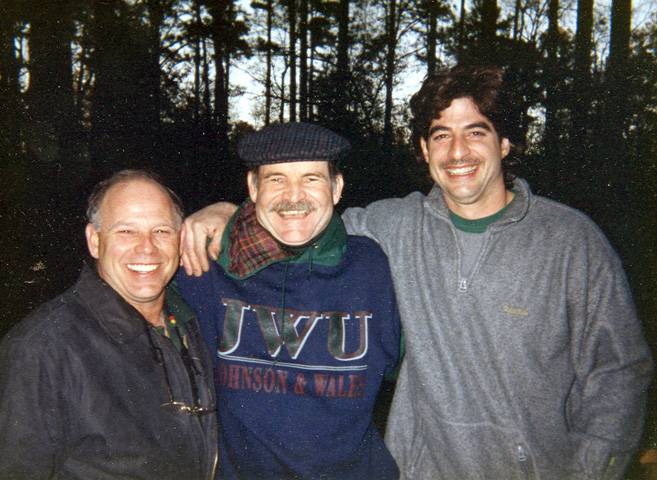
Gary Marchal, Vaughn Banting, and Guy Guidry.
(Rob Kempinski Facebook post, Feb.
26, 2017 ; "In Memory of Gary John
Marchal" ; "Biography: Gary J.
Marchal" ; The Indices 2004 ABS, pg. 88) SEE ALSO: Oct 11
(Photo courtesy of Alan Walker, 05/11/07) 2018 -- John Naka's one-time right-hand man and American bonsai master in his own right, Ben Oki died of a heart attack at the age of 91. See also this memorial from Bonsai Societies of Florida.. (02/23/18 Facebook postings by Robert Pressler, Ed Trout, Louise Leister, and others; 02/25/18 Facebook posting by Ted Matson) SEE ALSO: Jan 26 |
||||
| 24 |
1917 -- Toshio Kawamoto was born in the Kanto (Tokyo+) area of Japan,
the first of seven children to bonsai master Tokichi Kawamoto.
[He would graduate from Azabu High School and continue studying and
assisting his father. At
his father's death in 1960, Toshio would take over the family's nursery
Meiju-En, establish the Nippon Bonsai-Saikei Institute, and form the Nippon
Saikei Association. After WWII, bonsai had still been a creative
pastime of only a small number of wealthy enthusiasts and the sons of bonsai
specialists. Toshio would feel that this could become a popular hobby
that anyone could enjoy, regardless of social or economic class.
He would combine the best of group plantings and rock-grown bonsai, which
were increasing in popularity at the time. Due to shortages of suitable
mature material for bonsai, young specimens would be utilized by this author
and lecturer to successfully depict sections of natural scenery.
These containerized living landscapes of trees, rocks and mosses would
be known with the registered name of
saikei. His first English-language book would be
Bonsai-Saikei
(1963), followed by
Saikei: Living Landscapes in Miniature
four years later. He would write and illustrate articles on saikei each month in a series published in
Bonsai World
magazine. His first lecture-demonstration outside of the Kanto
area would be in Kansas City, MO in July 1972 for a joint ABS-BCI
convention and some 400 registrants.]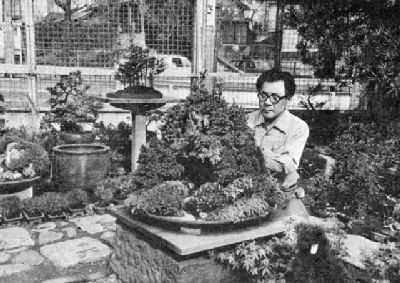
"Mr. Kawamoto and Saikei Exhibited at Expo '70."
("Sokumenzu - Profile" by J. A. Dillon,
Bonsai Magazine, BCI, June 1972, pg. 12;
Saikei: Living Landscapes in Miniature
by Toshio Kawamoto, 1967, pp. 7-8)
(Bonsai Magazine, BCI, June 1972, pg. 12) 1925 -- Norman Nelson was born, born in St. Louis, MO. [He would grow up on a farm in Dixon where his family would live during the Depression. He would graduate from Dixon High School in 1943, then attend Washington University in St. Louis for three years, where he would study horticulture. After college, he would do window displays for the Famous-Barr department store in St. Louis, where he would meet his wife, Mary, in 1949. The couple would marry on Feb. 18, 1950, and move to Fort Lauderdale two years later. Norman would work as a landscaper for a local nursery. He would become a bonsai expert and Curator of the Morikami Gardens in Delray, FL for about 10 years. Norm was a Lifetime Member of The Lighthouse Bonsai Society, The Gold Coast Bonsai Society, and The Naples Bonsai Society. Norm was also a member of The Bonsai Society of Florida; The Bonsai Clubs International; The Southeast Florida Bonsai Study Group; and Saint Elizabeth Ann Seton Catholic Church. He was an instructor in the Art of Bonsai in the Broward and Palm Beach County Adult Education programs and at his nursery, Bonsai Too in Coral Springs. He would own several nurseries during his lifetime before opening the nursery in Coral Springs, in April 1989 which would specialize in oriental gardens. ("Norman, Nelson," http://articles.sun-sentinel.com/1996-07-10/news/9607100097_1_funeral-services-pompano-beach-collins/4; James, Sallie with Carol Lewis "Norman Nelson, Curator Of Morikami's Gardens," http://articles.sun-sentinel.com/1996-07-09/news/9607080309_1_nelson-family-bonsai-mr-nelson; "Morikami Museum and Japanese Gardens," http://www.heathermccurdy.com/archives/2011/03/morikami_museum.html) SEE ALSO: Jul 8 1986 -- Robert "Bob" Yoshio Kataoka died in Denver, CO at the age of 77. (Born in Hiroshima, Japan in 1909, Bob came to America at age 17 with the intent common to most Japanese immigrants to make his fortune overseas and then return to Japan. But with his marriage to Hanayo Kameoka in 1937 and the birth of his two children, and the realization that truly America was the land of opportunity and future for his family, he stayed and worked diligently, sinking his roots in Delano, California. But the attack of Imperial Japanese forces on Pearl Harbor in Dec. 1941 brought tragedy and bitter hardship to the Kataoka family, as to 120,000 others of Japanese ancestry, of being driven from their home and then interned for the duration in American concentration camps in California, Arkansas, and Arizona. Released in May 1945, the Kataokas permanently settled in Denver, Colorado, where Bob earned his livelihood as an upholsterer. With the building of the Kataoka home in 1955, Bob began collecting mountain trees to create his Japanese garden. The collecting and sculpturing of these mountain trees for landscaping would easily and naturally lead to Bob's interest in bonsai. He was a founding member of what would become the Rocky Mountain Bonsai Society. His bonsai unmistakably reflected the style, flavor and influences of Japanese bonsai upon truly mountain-collected native American tree material -- junipers, fir, spruce, and Ponderosa, Limber and Lodgepole pines. He was a bonsai scholar who sought to adapt the techniques of black pine bonsai culture to the native Ponderosa pine. He kept careful records of his trials and their results. His best Ponderosa Pine became the logo of the Denver Junior Bonsai Club c.1969. It remained the logo when, during the latter part of 1975, the Senior and Junior Bonsai Clubs worked toward merging into one club, the Denver Bonsai Club, which then changed its name to the Rocky Mountain Bonsai Society in 1983. Bob was always ready to demonstrate grafting and other techniques. He was an expert in grafting all kinds of trees, particularly nishiki (corkbark) pines. His bonsai philosophy was pure, that you should enjoy the essence of the tree and the effort of the hobbyist, rather than look for faults. He explained that bonsai are trained, not tortured. "It is not neglect that creates the weathered look, but the right training." He was a guiding light for the RMBS as the result of reading many of the Japanese bonsai magazines and adapting the methods to local native trees, such as ponderosa pines. Bob's reputation and expertise as an American bonsai master was recognized before his untimely death and acclaimed by such acknowledged teachers as John Naka, Ben Oki, Ken Sugimoto, and Frank Okamura. Bob's bonsai reputation extended beyond the borders of the U.S.A. when he was acknowledged by Japanese bonsai master Kyuzo Murata, who, after viewing Bob Kataoka's bonsai garden in Denver, asserted his opinion that Bob's bonsai were one of the great representations of American bonsai art he had seen, and his artistry in creating bonsai was superlative and adhered to the purest traditions of the art.) [In 1986, the Bob Kataoka Memorial Award, "Artist of the Year," would be established in his honor and presented each year at their annual bonsai show at the Denver Botanic Gardens to a member who has developed a bonsai that is outstanding. His vision would be kept alive in the private garden by his daughter, Lily Uyeda, who uses the skills that he taught her. [Bob's magnificent forest of 47 Alpine Firs was prepared to honor the 47 Ronin, a revered and hallowed story of forty-seven masterless samurai who displayed eternal virtue and sincerity. This bonsai would become part of the Weyerhauser Company's Pacific Rim Bonsai collection in Federal Way, Washington State. Bob's wife Hanayo would join him twenty years later in January 2006.] 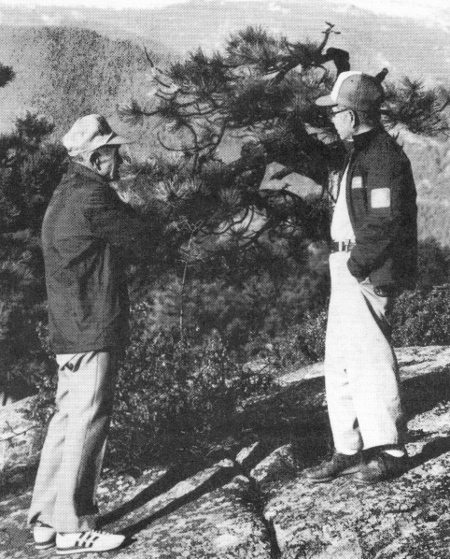
"Colorado's Sensei's Bob Kataoka (left) and [curator of the Denver Botanical Garden's Japanese Garden] Kai Kawahara
inspect
some of the local Ponderosa Pine just outside the [Aspen Rocks L]odge on the morning before the collecting tour began [on May 17, 1985 outside of Estes Park, CO] (Bonsai Journal, ABS, Vol. 19, No. 3, Fall 1985, pg. 13) 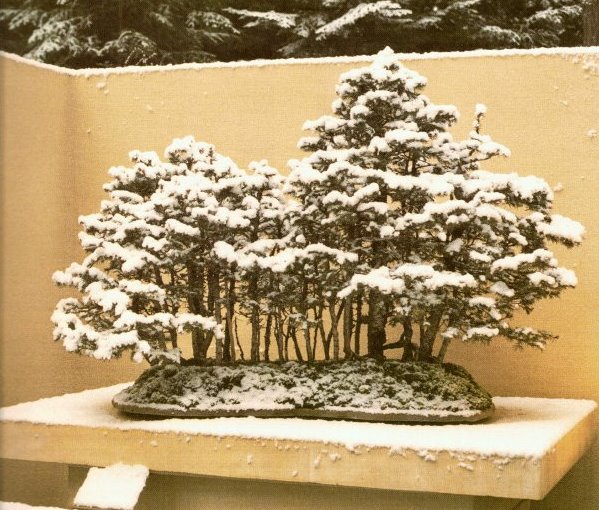
Subalpine Fir, Abies lasiocarpa
(Tsukiyama, Ted T. "Bob Kataoka: Rocky Mountain Bonsai Legend," Bonsai Magazine, BCI, July/Aug. 1991, Vol. XXX, No. 4,
pp. 3-8; Robinson, Jim "The History of the Rocky Mountain Bonsai Society,"
http://web.archive.org/web/20100105002824/http://www.rockymtnbonsai.org/html/ClubHistory.htm;
Lee, Kathy "Kathy's Korner," Fort Wayne Bonsai Club Newsletter, Vol 10, Issue 12, Dec. 2006, pp. 1-2
http://home.earthlink.net/~centaura/fwnewsletters_files/12-06%20december06.pdf;
"Yoshio Bob Kataoka,"
http://www.findagrave.com/cgi-bin/fg.cgi?page=gr&GSln=Kataoka&GSfn=Yoshio&GSby=1909&GSbyrel=in&GSdy=1986&GSdyrel=in&GSst=7&GScntry=4&GSob=n&GRid=47394380&df=all&)
SEE ALSO: Jan 5, Jan 12Height forty-five inches From the Pacific Rim Collection "According to Bob's wife, Mary, she and her husband collected approximately eighty seedlings along a logging road near Echo Park, Colorado in 1960. Forty-seven of these seedlings were selected for this group planting. It was originally on a sandstone slab that was broken in transit to Washington State. It is currently on a fiberglass slab, but will be returned to a natural stone in two years, when re-potting will be completed." (Excerpted from Bonsai Journal, ABS, Winter 1994, pg. 153) |
||||
| 25 |
1924 -- Kiichi "Wayne" Takayasu was born in Toyama, Japan to Sato and Chojiro Saiki. He was
1 of 12 children: There were 5 brothers and 6 sisters. [Wayne and his wife, Hatsuko, would marry on March
20, 1946. They would move to Guadalupe, California in 1957 and relocate to Santa Maria in 1965. Wayne would become a gardener
in 1962 and be a member of the Santa Maria Gardener's Association. He would retire in 2002 after forty
years. Wayne would be involved in Bonsai and be a founding member of the
Santa Maria Bonsai Club in 1968
with 11 other persons. He would be a President of the Bonsai Club at one point and be a member for 39
years. On October 1, 1990 one of Wayne's bonsai, a
California
juniper in training since 1967 and which he named "Kyokuryu" or "Sunrise Dragon," was selected to be on
permanent display at the National Arboretum's
North American Collection Pavillion in Washington D.C. After over 40 years, Wayne
would officially become a United States citizen on March 10, 1999. Wayne would be a member of the
Tenrikyo Church in Guadalupe and Lompoc.]
("Kiichi 'Wayne' Takayasu,"
http://santamariatimes.com/lifestyles/announcements/obituaries/obituaries/article_d308c10e-3908-52f5-acb6-0111b4765c2d.html)
SEE ALSO: Apr 14
1947 -- Dennis Makashima was born at Herrick Hospital (now Alta Bates Herrick) in Berkeley, California. A Sansei (third generation Japanese-American) his mother and father were both Kibei (born in the U.S., educated in Japan, and later returned to the U.S.). They had been interned at the Gila Camp in Arizona. [A graduate of Berkeley High School, Dennis would serve in the U.S. Army in Vietnam, and graduate from U.C. Berkeley, where he'd majore in Political Science. Dennis' interest in pruning would start in 1980, when he would practice on a friend's Japanese Black Pine tree. Since there were few pruning book available, he would use trees in natural settings and attractive material in urban gardens as his models. In 1982, he would have the good fortune to meet Mas Imazumi, a bonsai master in Northern California. They'd both be at a family party in Hayward, CA -- Mas' son would marry Dennis' wife's cousin. Dennis would overhear Mas talking about bonsai with some old timers there and soon after Dennis would sign up for Mas' five bonsai classes. At a nearby community place there''d say he just regurgitated what he knew about the informal upright style with a juniper. He'd explain the nuances of the style, the training wire for the trunk to be bent, and that was it. (He would estimate he gave 500 demonstrations over his career.) In 1984, Dennis would leave his job as a produce manager to work full-time as an ornamental tree pruner. Dennis would be a pioneer of Aesthetic Pruning (ornamental tree pruning up to 15 feet in heiwould create the now nationally renowned Aesthetic Pruning Program at Merritt College and would mentor over 100 apprentices during his illustrious career. A revered celebrity practitioner, he would prune over 10,000 trees, including in San Francisco's Japanese Tea Garden, a tree that Walt Disney personally planted in Disneyland, and Ruth Bancroft's Garden. In addition to their much sought-after commissioned work, he and his students would continue to volunteer their time pruning trees in Higashi Honganji Buddhist Temple in Berkeley and many other temples with Japanese garden-style trees in the San Francisco Bay Area. "Aesthetic Pruning embraces the creative interpretation of small trees and shrubs in the urban context. The living art form combines the artistic skills of the pruner, the essence of a tree, the science of horticulture and the needs of the clients and the surroundings." [In 1990-92, he would be selected to apprentice under Bonsai Master Yasuo Mitsuya for 18 months in Toyohashi, Japan. (Dennis would be about six months behind Kathy Shaner's training there.) He would dispose of all his trees before going to Japan -- who would take care of them when he was away? After returning from this training in Japan, Dennis would teach aesthetic pruning and, while rebuilding his personal collection, teach bonsai to students,. He then would travel the world giving workshops. He'd estimate that he gave a thousand trees. He would participate in the GSBF conventions in 1993, 1999, 2000, 2002, and 2005; joint BCI-GSBF convention in 1994 in San Jose, CA; BCI convention in 2001 on cruise from Miami to Bahamas; ABS seminars in Denver, CO in 1997, 2001 in New Orleans, LA, 2014 in Sacramento, CA; Pacific Northwest Bonsai Association convention in 1995; and International Bonsai Arboretum semniar in 1999. He would be active in the bonsai community and serve in leadership roles for the Golden State Bonsai Federation for 20 years, including as President from 2002 to 2004. Dennis would retire from tree pruning about 2018, and subsequently donate his bonsai collection and tools. At one time he'd have over 500 trees, many of which would be featured in the 2002 edition of the Sunset publications Bonsai Book. Dennis' bonsai works would be found in the prestigious Huntington Botanical Gardens in San Marino, CA, the Ritsurin Garden in Takamatsu, Japan, and also in the Bonsai Garden at Lake Merritt in Oakland, CA. A wonderful three-part episode of Bonsai Time Podcast would be recorded in mid-May 2023 "Bonsai Stories and Other BS with Dennis Makashima! Part 1 - Bonsai Time Podcast Ep 18." At the end of October 2024, his autobiographical e-book, Mr. Omoshiroi, Notes from a Baby Boomer Sansei and Bonsai Sensei, with Jennifer Hasegawa, would be available.] 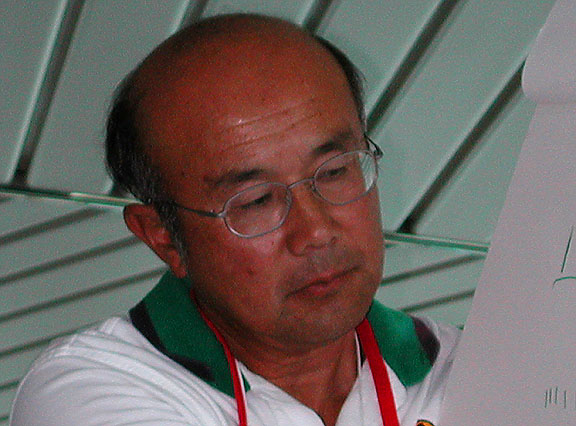
Dennis Makeshima, 10/18/01.
http://www.wayofmaple.com/dennis_makashima.html;
New
Bonsai Photo Exhibition at the Military Intelligence Service Historic Learning Center, National Japanese
American Historical Society, September 12, 2023; Hirai, Tom
"LIVING ART FORM:
Dennis Makishima's [sic] aesthetic pruning," Nichei Bei Weekly, August 16, 2018;
"Aesthetic Pruning embraces" quote per Lewis, Maryann
"Conifers and Aesthetic
Pruning," American Conifer Society, December 7, 2019 ; the three-part episode of the Bonsai Time Podcast recorded in
mid-May 2023 "Bonsai
Stories and Other BS with Dennis Makashima! Part 1 - Bonsai Time Podcast Ep 18"; The Indices 2004, ABS,
30(4):149 ['96]; Mr. Omoshiroi, Notes from a Baby Boomer Sansei
and Bonsai Sensei by Dennis Makashima with Jennifer Hasegawa, 1st page of Chapter 1 preview copy)
SEE ALSO: May 19, Dec 24
(Photo courtesy of Alan Walker, 05/11/07) 1978 -- The two-day organizational meeting of a group whose name was chosen to be "Golden State Bonsai Federation" (over 5 other contenders) began today in Santa Maria and ran from noon until 4:30 p.m. Thirty persons from Santa Barbara and the South and seventeen people from Santa Maria and the North attended. Jim Barrett was elected President. As early as three years previously, discussions had started lamenting the fact that there were so few opportunities to become better acquainted with the art of bonsai among the 40+ California state socieities. An initial meeting had been convened at Jim Barrett's on Sept. 15, 1977 with Jim Everman, Khan and Kay Komai, and Dick and Dixie Shaner to get the ball rolling. A letter and questionnaire were drafted over the next week and sent out to all known state bonsai clubs and teachers. The response was so overwhelmingly positive that additional letters were sent out settling on a convenient date for all parties to meet regarding a "Federation of California Bonsai Societies." ("The Early Years: Part 1 -- Getting Organized" by Bill Hutchinson, Golden Statements, GSBF, Vol. XXV, No. 1, January/February 2002, pp. 15-17; "The Early Years: Part 2" by Bill Hutchinson, Golden Statements, GSBF, Vol. XXV, No. 2, March/April 2002, pp. 12-14) SEE ALSO: Jan 1, Mar Also, Sep 9, Dec 22. 2005 -- Hideko Metaxas of Larkspur, California was awarded the Agricultural Society of Japan's Green and White Award, during a conferment ceremony held at Consul General Yasumasa Nagamine's temporary residence in San Francisco, for her enduring contributions towards US-Japan understanding in the fields of Bonsai (miniature potted tree cultivation) and Ikebana (flower arrangement). (Established in 1881, the Agricultural Society of Japan was the first nongovernmental agricultural organization formed in modern Japan. Since 1894, it has conferred the Green and White Award to recognize and honor those who have made significant and lasting contributions to mutual understanding and friendship between Japan and California. The society is a non-profit, public benefit corporation and all of its patrons have been members of the imperial family.) (Hideko Hidemika Metaxas was born in Yamagata Prefecture, Japan and she studied English as a young woman. She worked as a telephone operator at a U.S. Army base, where she met her future husband. After their marriage, they moved to the San Francisco Bay Area in 1953. She continued her education and received a degree in ornamental horticulture from City College of San Francisco. She began her study of bonsai in 1970 with Bob Kato and by 1974 she had begun ikebana studies with Mrs. Kinko Saiki. She now teaches that art as a Senior Professor, 4th grade. She has been a bonsai artist for an even longer period of time. Her bonsai activities have won her an international recognition. Thanks to her bonsai contacts in Japan, Hideko was responsible for introducing to the Western Hemisphere the following bonsai sensei: Masahiko Kimura, Yasuo Mitsuya, Kunio Kobayashi and Masamitsu Kubota! Hideko has held major offices in Bonsai Clubs International and was the 1990-91 president of the prestigious Golden State Bonsai Federation. She is also well-known as an interpreter for visiting Japanese teachers at conventions and club meetings. And she began to study the art of suiseki by 1980. She was a charter member of the San Francisco Suiseki Kai, under sensei Keiseki Hirotsu. She co-wrote "Introducing Suiseki," one of the earliest and best articles on suiseki in the March/April, 1984, issue of the journal Golden Statements. The GSBF awarded her its President's Award for distinguished service in 1996, for she also was a trustee, committee chair, program coordinator, and convention demonstrator for them. A woman of abundant vigor, she also manages to study calligraphy, ceramics, and brush painting.) 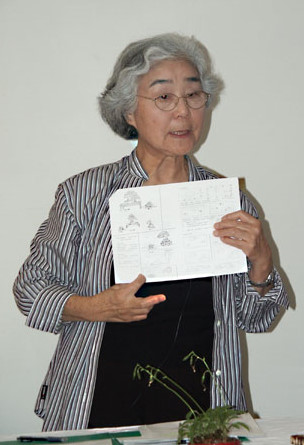
Hideo Metaxas, 09/06/03.
("Agricultural Society of Japan Green and White Award Conferment Ceremony," 02-16-2005,
http://www.sf.us.emb-japan.go.jp/archives/PR_e/2005/pr_05_0216.htm;
http://www.sansui-kai.com/announcements_layer.htm;
"Hideko Hidemika Metaxas,"
http://www.felixrivera-suiseki.com/galleries/hideko.html;
"Friday, November 17, 2006, IN TOUCH WITH NATURE, Hideko Hidemika Metaxas, Ikenobo School,
http://www.ikebana.org/Events/Nov2006/OnStage11172006.html)
SEE ALSO: Mar 4, Mar 31, Apr Also, Sep 14.
(Photo courtesy of Alan Walker, 05/11/07) |
||||
| 26 | 2021 -- Ivan Watters passed away at the age of 85 after a severe illness. (In 1960 he began styling bonsai after being injured and was no longer able to play a violin. He started serious study in 1975 with Harold Lenz (Chicago) and Toshio Saburomaru (California). He began teaching bonsai in 1979 and instructed all levels. Ivan continued advanced studies with Susumu Nakamura in Yokohama Japan, beginning in 1987. He was one of the founding members of the Midwest Bonsai Society, and was a current board member and sensei. He also was one of the founders of the Prairie State Bonsai Society. From 1996 to 2005 he operated the Yasukanai Bonsai Garden in Morton Grove, IL. He visited the Kokufu-ten in Tokyo at least 20 times, was a long-time member of the Nippon Bonsai Association which sponsors the show, and was instrumental in getting Nakamura to donate 19 of his Kokufu-worthy trees to the Chicago Botanic Garden in 2000. Ivan was curator of the bonsai collection at the CBG from 2007-2014. With Nakamura he co-wrote Bonsai: A Patient Art which was published in November 2012. See Ivan's CV here.) ("Ivan Watters Passsing," posting in Bonsai Nut, Feb. 28, 2021; MacNeil, Kathy "Living art: Bonsai teaches lifelong lessons, NWI Times, Aug. 11, 2011, Updated Jun 18, 2017; "The Art of Bonsai," Anderson Japanese Gardens, May 2016; Cooper, Dean "March 2021 Message from the President, Prairie State Bonsai Society, March 2, 2021 ; "Journey to Kokufu," Chicago Botanic Garden blog, April 4, 2013; "Ivan Waters Achievements"; "Bonsai: A Patient Art, Yale University Press) SEE ALSO: Jun 4, Jul 25 | ||||
| 27 |
1921 --
Yuji Yoshimura
was born at the Taiko-En Bonsai Garden in Tokyo, Japan. He was the
second son of Toshiji Yoshimura, a leader in the bonsai world whose father
himself was a samurai and renowned garden designer. [Three years
later, the elder brother would die in childhood and the family bonsai tradition
would pass on to Yuji who would one day leave his mark on the art in many
places outside of his native land.]
("Yuji Yoshimura,
A Memorial Tribute To A Bonsai Master & Pioneer" by William N. Valavanis,
International Bonsai, IBA, 1998/No. 1, pg. 30;
Golden Statements, Golden State
Bonsai Federation, Sept/Oct 1994, pp. 23-24) SEE ALSO:
Jan 12, Apr 23, Jul 17, Dec 24
1972 -- Nonkey Torazo Ishiyama, died at the age of eighty-one. The McLean, VA owner of Beeches Nursery was a graduate of Chiba University in Japan, a professional horticulturist in landscape design, Japanese gardens, nursery ornamentals and bonsai. Nonkey had three articles published in the ABS Journal from 1969 to 1971, the last one being "Historical Notes on Japanese Bonsai" (Fall 1971, pp. 43-44). (Note at the end of the reprint of "Pruning Of Bonsai" by Nonkey T. Ishiyama, Journal, ABS, Vol. 21, No. 2, Summer 1987, pp. 8-9) |
||||
| 28 |
1890 -- Kanzan (Kanzan Denshichi) died. (Born in 1821 in Seto in Aichi Prefecture, he was
the third son of the potter Kato
Koubei. Starting from the second year of Bunkyu (1862) Kanzan briefly worked at a Koto-ware kiln, the Hikone Domain
kiln of Ii Naosuke. The kiln closed later that same year and in September he moved to Reizan (Higashiyama-ku, Kyoto),
setting up a kiln. As Kato Mikiyama/Terao Denshichi (1863), he was the first ceramicist to specialize in the porcelain
manufacturing business in Kyoto. In the first year of the Meiji era (1868) he worked to supply the Kyoto Prefectural
Office. Two years later he studied and succeeded in trying the 13 styles of Western painting (such as Western cobalt)
under the instruction of Gottfried Wagener/Wagner and produced
Japan's first Western-style paintings. In the following three years, production was renamed Matsuuntei and he worked
under the name Kato Mikiyama/Kanzan. In 1871, he took over Western style painting from Wagner. And in 1872 he
adopted the family name Yama/Kanzan Denshichi (until 1885), and ushered a new phase into traditional
Kyoyaki. In 1873, he was
awarded a silver medal at the Austrian Grand Exposition,
only the first international exposition where he received high appraisal. In the same year, he received an order for
Western-style tableware and crockery for the Imperial
Household Ministry's reception. He was finally able to invest in a state of the art round kiln, the best in Kiyomizu,
Kyoto. Kanzan's works include porcelain tableware, both Western and Japanese in style, often decorated with brightly
colored polychrome and gold. His fame spread throughout the country and abroad, and his large-scale workshop
and factory was often visited by dignitaries. However, this honor was due to the presence of influential patrons, such
as the governor of Kyoto Prefecture who was an enthusiastic supporter of the company, and excellent craftsmen, the best Kyoyaki
potters who were headhunted to form a stable of the highest order creating superb porcelain works. (These refined works were very highly prized by collectors overseas and the majority of works were destined for export, leaving very few pots in Japan. Many of the pots were fired first in the workshop before being painted with scenes that would appeal to the export market. The Victoria and Albert Museum would later acquire a pair of vases displayed at the Philadelphia Centennial Exhibition of 1876, a pair of ginger jars and four other small pieces. Kanzan secured a gold medal at Paris in 1878 with newspapers noting that the pieces displayed had something of the character of Sèvres. In 1881 during their visit to Japan, Queen Victoria's grandsons -- Prince Albert Victor, Duke of Clarence and Avondale, and Prince George, Duke of York (the future George V) -- visited Kanzan's workshop in Kyoto where they bought a few pieces as well as attempting to make their own pieces on the lathe. Kanzan's personality was warm, mellow, honest, and taciturn, and he never made a single item or artifact without consideration for its value. His specialty was thin wares, such as Tenmoku tea bowls, which were so thin that they were almost paper-thin and weightless. The Mikiyama Pottery Company was established in 1885, primarily providing Western-style tableware to various departments in the Imperial Household Ministry. The products were inscribed with "Mikiyama Seisan" or "Dainippon Mikiyama," and the "Dainippon" was intended for export to foreign countries. At its peak, Kanzan's workshop had up to 100 craftsmen, but mismanagement led to the dissolution of the workshop in 1889 and the Kanzan Toki Kaisha (Kanzan Ceramics Company) factory was sold. Mikiyama continued to produce pottery at his home, but died early the following year at the age of 70.) [The technique of colorful iro-é brushwork and intricate overglaze patterns would preserve the "Kanzan porcelain" appellation for over a century, and it would still exist today. Kanzan Shigeta, born in Kyoto in 1973 would be the eighth generation of Kanzan ceramic artists and would have had his formal apprenticeship under his father, Kanzan Denshichi VII.] Why this is important to us: Kanzan was also very well-known in the bonsai world, bequeathing a number of highly artistic specimen containers. ("The artistic beauty of pots," translated by Peter Warren fron Kinbon magazine article, Bonsai Focus, 130/107, 6/2010, Nov/Dec, pg. 58; "Kanzan Denshichi," The British Museum; "Kanzan Denshichi," Ceramics Story; "Denshichi Kanzan," www.Satsuma-database.com; "Kanzan Denshichi," Antique shop Chano-yu; "A JAPANESE PORCELAIN VASE BY KANZAN DENSHICHI (1821-1890)," Invaluable.com) 1917 -- Masaharu Imazumi was born. [Born in the U.S., he would move with his family to Fukuoka, Japan when he was three months old and live there until he was thirteen years old. His father would then move them back to the U.S. where Masaharu would serve in the Army during WWII. Then starting with gardening and landscaping, he would become involved with bonsai and be a teacher, primarily in California.] (SSN Master File by Birthdate) SEE ALSO: Dec 24 1963 -- The Bonsai Society of Greater New York was organized under Yuji Yoshimura's guidance. [The group would start meeting, on May 15, at the New York Botanical Gardens where it didn't have to pay any rent. An annual show would be held and a bonsai bulletin would be printed for the membership.] ("Interview with a Legend" by Jill Hurd, Journal, ABS, Winter 1997, pg. 146) SEE ALSO: Jun 9 1963 -- The First Annual Meeting of the Bonsai Clubs Association, a group of six California clubs, was held. Robert C. Miller, Jr., the BCA Newsletter Editor, was elected the first president. [In five years the BCA would be renamed Bonsai Clubs International.] ("Hindsight on BCI" by Tom Heitkamp, Bonsai Magazine, BCI, Jan/Feb 1978, pg. 4; "The President's Message" by Ray Boardman, Bonsai Magazine, BCI, Vol. XVI, No. 1, Jan/Feb 1977, pg. 11) SEE ALSO: Jan 30, Apr 16, May Also, Oct 22 2003 -- The declaration and signing of the Asia Pacific Bonsai Friendship Federation (ABFF) Charter and By-Laws was conducted smoothly at the Saiseki Restaurant in Manila. Attended and signed by Malaysia, Philippine, Thailand and Indonesia, the event was also witnessed by Pius Notter (Switzerland), I Chi Su (Taiwan) and an Indian representative. [Although representatives from Vietnam and Korea did not come to Manila, the Vietnam representative would sign both the declaration and the Charter at the subsequent first ABFF meeting in Jakarta, and the Korea representative would send its approval through fax, so 6 out of 7 of the initial country members would have signed off.]
2023 -- Marybel Balendonck passed away at age 97. (She was born in Dallas, Texas, grew up in the city and graduated from Sunset High School there in 1943. She worked in a variety of professional offices in Dallas including the electronics firm Texas Instruments, and obtained a pilot's license while working at a Dallas area airport. This was before she had a driver's license, chiefly because she hesitated to drive after a serious car wreck with her family when she was a child. Marybel married William (Bill) Balendonck in 1949 and the couple lived and worked in Dallas before moving to Fullerton, California in 1965. They bought an apartment four-plex soon after arriving, and two other small apartment buildings nearby in subsequent years. They rented units while Marybel worked as a contract administrator for Hughes Tool and Bill worked in sales for a meter company. Asian arts captivated her, and she became intrigued with the ancient Japanese discipline of bonsai cultivation. She began to teach herself bonsai through the relatively few books then available. She started her formal training in 1965 as one of John Naka's principal students and dear friends but also studied under prominent artists like Melba Tucker and Harry Hirao. Marybel hosted classes in her Fullerton garage led by John Naka. She joked that she was trying to keep up with her husband Bill, an avid musician who played saxophone with a local jazz group at area clubs. When John Naka invited her to join his select study group of bonsai artists based in Southern California, Nampu Kai, she was the first non-Japanese member. Although she was worried that she didn't speak Japanese, Naka reassured her that what mattered most was that she spoke bonsai. Husband Bill passed away in 1977. In 1982, Marybel helped found the National Bonsai Foundation, which was created to oversee the national bonsai collection at the National Bonsai & Penjing Museum at the National Arboretum in Washington D.C. A great and tenacious fighter and promoter of NBF and the Museum, she served on the NBF Board of Directors until 2020. "My Bonsai Hero" was an article about Ted Tsukiyama that she wrote which was in the Winter 2001 NBF Newsletter. She was instrumental in raising funds to build the John Naka American Pavilion of Bonsai adjacent to the Japanese Pavilion, which houses bonsai given to the U.S. by Japan to celebrate the U.S. Bicentennial in 1976. She stood next to John Naka and his wife Alice when the Naka Pavilion was dedicated in October 1990. Her own magnificent windblown elm (Ulmus parvifolia 'Catlin') forest of at least 16 trees was begun in 1970 and has been part of the museum collection since 1990, once on display at the White House. Her liquidambar grove and other bonsai she cultivated are housed at the Huntington Library and Gardens, the Japanese American Cultural Center Los Angeles, and the Bowers Museum in Orange County, California. Marybel was a key player in the fundraising efforts for several Museum structures and was known for her generous heart. The California Bonsai Society and other friends of Marybel helped to fund the Research Center of the Museum's exhibits gallery, recognizing her contributions toward the Museum's completion. She was active in bonsai clubs including the California Bonsai Society (creating brochures for this and Nampu Kai), Santa Anita Bonsai Club, and was an original member of Kofu Bonsai Kai. She also was a founding member of the California Aiseki Kai club for suiseki. She was awarded the 1994 Ben Oki Award by the American Bonsai Society. She led a long life of achievements in the field of American bonsai, world travel to help connect the far-flung bonsai practitioners in East Asia, the U.S., and Europe, and enjoyed a long career in office administration and contract management in Texas and California.)
Marybel Balendonck, Goshin and John Naka, undated.
("Marybel
Balendonck Obituary," The Orange County Register ;
"In Memoriam: Marybel Balendonck,"
National Bonsai Foundation Blog, March 27, 2023; Manning, Cheryl
"Vision Accomplished" ;
Schoech, Wayne "The Last Of The North American Collection,
Bonsai Bark, May 8, 2023) SEE ALSO: Mar 12, Aug 26, Oct 1, Oct 3, Dec 13
(Photo courtesy of Alan Walker, 05/11/07) |
||||
| 29 |
|
